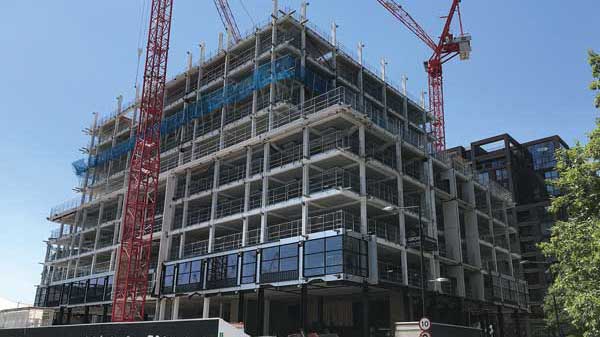Projects and Features
Trusses create vital column-free capacity
Providing end-user KLM UK Engineering with additional aircraft maintenance and repair capacity, a new £7M steel-framed hangar has landed at Norwich Airport.
FACT FILE
Norwich Airport hangar
Main client: Norwich Airport
Architect: Stephen George & Partners
Main contractor: MJS Projects
Design and build steelwork contractor: REIDsteel
Steel tonnage: 340t
With a catchment area that extends beyond the boundaries of East Anglia, Norwich Airport serves more than 500,000 domestic and international passengers every year.
It is the only passenger airport in the region; the next closest being London Stansted, which is more than 80 miles away.
Like many airports, Norwich was once a military establishment; RAF Horsham St Faith during the Second World War in this case.
For the last three years of the War, the United States Army Air Forces (USAAF) used the facility, and after hostilities the Royal Air Force remained on site until 1967.
In the following years, it was gradually converted into a passenger airport, with a main terminal opening in 1988. Today, many of the former military buildings remain, although they have been refurbished for a variety of new purposes. Five pre-war hangars are also still in existence, one of which has been converted into an aviation academy (see NSC January 2017).
The latest development at Norwich Airport consists of a new £7M scheme for end-user KLM. The project has created a 5,016m² Maintenance Repair Overhaul (MRO) hangar – large enough for two A320 aircraft – with an adjacent 1,400m² workshop.

Interestingly, Netherlands-based KLM is a major operator at the airport and its service to Amsterdam is the busiest route to and from Norwich.
The new MRO hangar is said to provide significant new capacity for KLM at Norwich Airport to provide high-quality maintenance, repair and overhaul services for its aircraft.
As with all aircraft hangars, this project was built around the need for large column-free spans, a requirement best served with a steel-framed solution.
A specialist contractor in this field of construction for more than 100 years, REIDsteel designed, fabricated and erected the steel frame for this project, as well as undertaking the installation of cladding, glazing and internal ladders.
This was not the first time the company had worked at Norwich Airport, as it has erected a number of other steel-framed structures on the site. Stretching back over 30 years, it previously worked on a customs bonded warehouse with an arch span portal frame design in 1989, a cargo centre in 1998 and the refurbishment and extension of a hangar in 2006.
MJS Projects Director David Henry says: “The Reidsteel pre-construction team were very attentive and came to meet us to discuss the project in detail. This gave us confidence in their knowledge and expertise and they gave us invaluable information on construction method and programme options.”
REIDsteel brought its value engineering expertise to rationalise the scheme’s structural steel design, which led to savings in both time and money.
The hangar is 16m-high to the eaves, measures 91m-wide × 55m-deep, and consists of two equal spans of 45.5m.
Creating the all-important internal column-free space is a central spine ‘King’ truss, supported at either end of its 55m-length by two lattice columns. The spine truss supports a series of roof trusses on either side, which are also supported on perimeter columns.
The spine truss, along with its two supporting columns, was among the first steelwork elements to be erected. The truss weighs 36t, was brought to site in three welded sections and assembled on the ground, before being tandem lifted into place by two 250t-capacity mobile cranes.
Once this central element was in place, the two rows of 45.5m-long roof trusses were lifted into place sequentially, between their supporting perimeter columns and the king truss.
“The roof trusses weigh 6.5t each and were delivered as their component pieces,” explains REIDsteel Project Manager Zacc Richards. “The trusses were assembled on temporary trestles, before they were individually installed with a series of two-crane tandem lifts.”
All of the hangar’s roof trusses are the same with the exception of the two that support the pair of megadoors, which are positioned at one end of the building.
These trusses are deeper than the others, at 4.5m, and were brought to site piece-small. All of their bolted connections were completed, then the 15t elements were lifted into place.
Stabilising this large open-plan structure is a system that includes V-shaped SHS steel bracing along each of the 55m-long elevations, and SHS bracings in the roof that form a X-shape on plan across both spans.
All of the bracings take the structure’s loadings to the four corners of the hangar, with the load path then continuing into the supporting pad foundations at the bottom of the “V’s”.
Sat adjacent to the hangar, the project also includes a 40m × 36m portal-framed workshop building. This steel-framed structure is 7.5m-high to the eaves and includes a mezzanine floor that spans over approximately one-third of the internal floor space.
As well as choosing structural steelwork for its long span attributes, the material is also a favoured framing solution because of its speed of construction.
Summing up, Mr Henry says: “Site works were organised, safe and delivered to programme and to a high standard. Even as the pandemic took hold, Reidsteel spoke with us clearly and sensibly and we agreed a safe and suitable way forward, which we could pass on and agree with our client.”
The hangar and workshop are now fully functioning and important additions to Norwich Airport.















